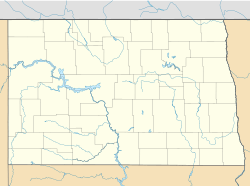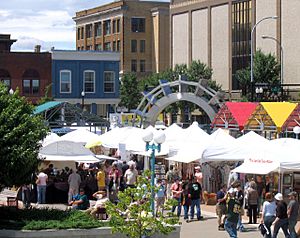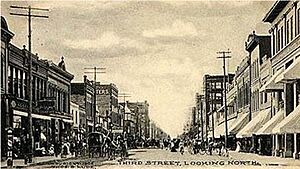Downtown Grand Forks facts for kids
Quick facts for kids |
|
|
Downtown Grand Forks Historic District
|
|
| Location | Downtown Grand Forks, at the Red River of the North, Grand Forks, North Dakota |
|---|---|
| Area | 80.4 acres (32.5 ha) |
| Built | 1872, 1880 and 1885 |
| Architect | Buechner & Orth; et al. |
| Architectural style | Various |
| MPS | Downtown Grand Forks MRA |
| NRHP reference No. | 05001475 |
| Added to NRHP | December 28, 2005 |
Downtown Grand Forks is the very first business area of Grand Forks, North Dakota, in the United States. It sits on the west side of the Red River of the North, close to where the Red River and the Red Lake River meet. Even though it's not the main shopping spot anymore, downtown Grand Forks is still the city's historic heart. A big part of it, about 80 acres, was added to the National Register of Historic Places in 2005. This special area is called the Downtown Grand Forks Historic District. Today, you can find many offices, shops, restaurants, and fun places in downtown Grand Forks.
Contents
How Downtown Grand Forks Began
Early Days of Grand Forks
Grand Forks started as a settlement in 1870. In 1872, seven brave pioneers claimed land along the Red River. The land that became downtown Grand Forks was first planned out in 1875. This was done by Alexander Griggs, who is known as the "founding father" of Grand Forks, and his wife Etta. They planned it because they expected a railroad to arrive soon.
Simple wooden buildings quickly appeared. By 1880, the new city had 1,705 people. Grand Forks officially became a city on February 22, 1881.
A Growing City
When the Saint Paul, Minneapolis, and Manitoba Railway arrived in 1880, Grand Forks grew very fast. New, taller brick buildings replaced the old wooden ones. Buildings like the Hotel Dacotah and the Security Building were five stories tall. This showed that the city was doing well. Downtown Grand Forks became one of the busiest business areas in the whole region. By the early 1900s, downtown Grand Forks was the main place for business, travel, healthcare, fun, and culture. It had many great features for its residents.
Changes Over Time
The 20th Century and New Challenges
For much of the 1900s, downtown Grand Forks was the most important business area. But later in the century, things started to change. New highways and shopping malls built outside the city caused downtown to become less popular. Big shopping centers like South Forks Plaza (in 1964) and Columbia Mall (in 1978) moved many businesses away from downtown. Over time, important places like hospitals, the post office, and the public library also moved to new buildings outside the downtown area.
In the 1960s and 1970s, a big project tried to update downtown. Whole blocks were torn down to make way for new office buildings and a city auditorium. A new bridge was built over the train tracks. To compete with the new malls, the City Center Mall was created. One whole block of South Third Street was covered with a roof to make an indoor shopping center. But this mall didn't work out very well. The 1980s and 1990s saw little new building downtown. Many big stores closed or moved away.
The Big Flood of 1997
The 1997 Red River flood caused huge damage to downtown Grand Forks. The entire area was covered by several feet of water. A major fire also destroyed eleven old buildings. A famous image from the flood was the burned and flooded shell of the five-story Security Building.
After the flood, people worked hard to make downtown great again. A new Grand Forks Corporate Center was built to replace offices lost in the flood and fire. The old Empire Theater was fixed up and became the Empire Arts Center. The roof of the City Center Mall was removed, so the historic storefronts could be seen again. Other projects after the flood included new offices for the Grand Forks Herald newspaper and Grand Forks County. A new "Town Square" community park was also built. Many other downtown buildings were also fixed up, like the Metropolitan Opera House.
A Special Historic Place
The Downtown Grand Forks Historic District is a special area of about 80 acres. It was added to the National Register of Historic Places in 2005. This means it's recognized as an important historic site. It's also known as the Grand Forks Original Townsite and the Central Business District.
Some important dates for this historic area include:
- 1872: When settlers first claimed land by the Red River.
- 1875: When the town was first planned out.
- 1880: When the first railroad reached the city and went right through downtown.
- 1885: When another railroad line, the Northern Pacific Railway, arrived.
- 1997: When the Red River flood covered all of downtown. This flood and the fires caused a lot of damage, but also led to new building and fixing up.
Many different architects designed buildings in this area. Some famous ones include Buechner & Orth, Joseph Bell DeRemer, Cass Gilbert, and Theodore B. Wells.
When it was listed, the district included 42 buildings that add to its history. It also had four historic structures and 15 newer buildings.
Downtown Today
In recent years, many new stores and restaurants have opened downtown. The city has been encouraging new apartments and condos to be built in the area. Now, you can find nice homes in new or fixed-up buildings, sometimes even above businesses.
Also, a farmer's market is held every Saturday from mid-June to mid-September. You can find it in the Town Square, at the corner of 3rd Street S. and DeMers Avenue.
Every June, downtown and the nearby Greater Grand Forks Greenway host the Grand Cities Art Fest. This is a fun event where you can see lots of art.
Important Buildings
- Central High School
- Grand Forks Herald
- Metropolitan Opera House









